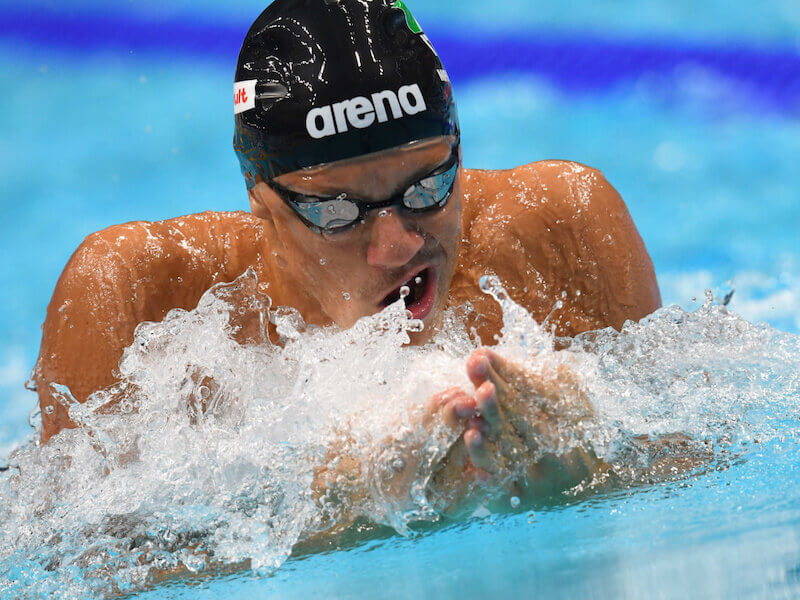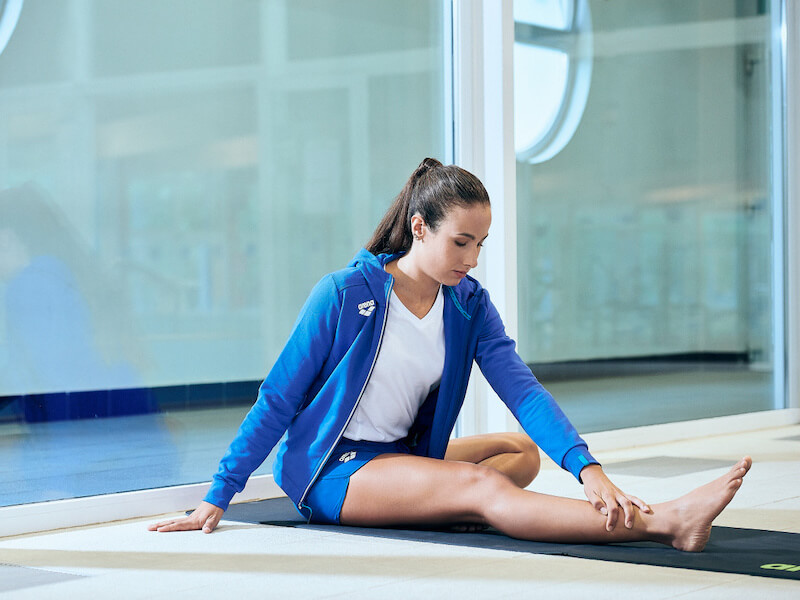Swimmer’s Knee From Breaststroke: Causes and Prevention
Most people think of swimmer’s shoulder as the most common swimming injury, but have you ever thought about knee pain as a swimming-related injury? Swimmer’s knee mostly affects breaststroke swimmers and is caused by the strain that the breaststroke kick places on the medial collateral ligament (MCL).
While this knee pain, also called breaststroker’s knee, is common, it is also preventable. Whether you are new to breaststroke or are an experienced breaststroker with some knee pain, this article will help you avoid swimmer’s knee.
We’ll cover the causes of swimmer’s knee and what you can do to prevent it, like a proper warm-up, stretching, and dryland exercises, which can increase the flexibility and strength of your knees.
Why Is the Breaststroke Prone to Swimmer’s Knee?
The breaststroke is one of the most complicated swim strokes to learn and requires a completely different technique than the other three swim styles.
One of the differences between this style and the others lies in the distribution of forward propulsion. In breaststroke, 70% of your propulsion comes from your legs, with the rest of the power coming from your breaststroke arm pull, meaning there is more strain put on your legs and knees than in any of the other swim strokes.
The most popular breaststroke swimming technique is the so-called whip kick motion. This technique involves bending your legs toward your thighs and your thighs toward your hips at an angle of approximately 120 degrees, with your feet almost at the surface of the water and your knees quite close together.
Your feet then begin to sweep outward to get into the right position to push against the water. You push with the inside of your feet, performing an energetic out-and-in whipping motion. Having completed this phase, your feet will be together and completely relaxed during the glide phase of your stroke.
The legs play a key role throughout the entire stroke, particularly the position of your knees. That is why the knees are a breaststroker’s weak point.
What Leads to Swimmer’s Knee?

The knee is a hinge joint that bends and has a slight ability to rotate from side to side. The joint is where the femur and the tibia meet. The bone of the kneecap is called the patella. Four major ligaments connect these bones of the knee. The end of each bone is padded by cartilage called a meniscus. Large adductor muscles like the hamstrings and quadriceps also play a role in the mobility and stability of the joint.
The primary problems that can lead to swimmer’s knee are stability and flexibility issues. If these problems are neglected, a swimmer can experience more severe forms of knee injury, like dislocation or torn ligaments. These injuries could result in a lot of time out of the water — something you don’t want as a competitive swimmer — and could also mean physical therapy or orthopedic surgery.
Knee Stability Problems
A lack of stability in the kneecap plays a big role in causing swimmer’s knee. If your knee is unstable, you could be prone to developing knee pain from swimming breaststroke. The force generated by the breaststroke kicking motion creates an unnatural lateral flexion in the knee, putting stress on ligaments, especially in a knee that is not stable.
One of the most common causes of knee injuries comes from these stability difficulties. The knee’s ligaments can become strained from overuse and the unnatural lateral flexing caused by the breaststroke kick.
Poor stability can lead to misalignment in the knee joint and can be caused by repetitive strain occurring over the course of several years. This causes damage to the surface over which the knee articulates. The meniscus and muscle can become worn and damaged due to a misaligned knee, causing further stability and control problems.
Poor Knee and Hip Flexibility
Poor flexibility in the muscles that support your knee can lead to unnecessary strain on the joint. Tight muscles are prone to injury. Not only can you injure a muscle itself, but you can also injure a ligament if your muscles are not stretched properly.
The quadriceps and the hamstrings are the main muscle groups that need to be stretched to keep your knees healthy. Long and limber muscles will reduce the amount of stress your knee joint takes while swimming breaststroke and instead allow the muscles to bear some of the lateral movement.
Another reason many breaststrokers experience knee pain is due to poor hip flexibility. Swimmer’s are more likely to experience knee pain if their hips have a low level of internal rotation during the breaststroke leg kick. This is caused by tight hip flexors and poor hip abduction.
How You Can Prevent Swimmer’s Knee

The best way to prevent swimmer’s knee is to avoid the two problems mentioned above, that is, poor stability and flexibility in the knee joint. You should strengthen your legs and keep your muscles stretched to combat these issues.
The best methods to keep your knees healthy for breaststroke swimming are to warm up properly, stretch regularly, listen to what your body is telling you, and strengthen the muscles surrounding your knees with dryland exercises.
Properly Warm-Up Before You Swim
Warming up is one of the most important aspects of any athletic activity. However, many individuals overlook the necessity of it because they are crunched for time or too eager to get their main workout underway.
No matter how much you want to jump right into your main set, performing a thorough warm-up to prepare your body for exercise is imperative. Your pre-exercise routine should include the following:
- Dynamic stretching before you start swimming (and don’t forget to stretch your legs!)
- Swimming easy at first to get your heart rate up and increase your muscle temperature
- Incorporating a moderately challenging breaststroke set into your workout before you begin the most challenging part of your swim
Routinely Stretch After Your Workouts
Just as a warm-up is essential for athletes, so too is recovery stretching. Proper recovery stretching will help your muscles heal more quickly after strenuous use. Your muscles will be lengthened during recovery stretching, and you will not be as sore in the days following your workout.
Your recovery stretching routine should include the following:
- Use a foam roller to massage any knots out of your muscles. Focus on the muscle groups surrounding your knees.
- Consider practicing yoga or otherwise develop a good stretching routine for the large muscle groups in your legs. Hold each stretch for at least 20 seconds, or longer if you can.
- Static stretching is the best form of muscle recovery and will keep your legs limber, improve hip abduction, and benefit your knees. Plus, this could help if you have any lower back pain.
Listen to Your Body
One of the best ways to understand what your body needs is to listen to it! If you feel like something is not quite right in your knee, then it might be time to take a rest. Reducing the amount of activity responsible for causing your pain is the best way to aid your body in recovery.
If you feel inflammation in your knees, to reduce swelling, you can try icing them or taking over-the-counter anti-inflammatory medicine — remember that this should be done under medical supervision, so you should always ask your doctor first. If the pain in your knees persists, you should talk to your coach or see a healthcare professional, like a physiotherapist or sports medicine doctor.
Remember to listen to your body if you feel any of the following:
- Knee pain that remains or gets worse after swimming breaststroke
- Sudden knee pain during practice or an event
- Knee pain outside of the pool that affects your daily life
Dryland Exercises to Improve Knee Strength

To prevent or reduce the aforementioned problems, below are three dryland exercises we suggest including in your weekly training plan. Taking the time to perform these exercises will strengthen the muscles around your knees, which decreases knee strain from the breaststroke kick.
These exercises will also increase the range of motion in your hips and lower legs, preventing further knee pain. Throw on your athletic gear and get ready to strengthen those legs!
Exercise 1: Traditional Squats
Stand with your heels slightly wider apart than your shoulders, making sure your toes are pointing outward at an angle of approximately 30 degrees. Move your hips back slightly so that you can feel the pressure on your thigh muscles.
Slowly bend your legs as you lower your body, without dipping down suddenly, keeping your muscles tense and avoiding any lateral movements of your knees. Bend at the knees until your thighs are parallel to the ground or, if you prefer, until your hips are the same height as your knees.
Begin without using any weights. Perform the movements slowly, focusing on the muscles in the front of your thighs. Begin by performing three sets of 12 repetitions.
Exercise 2: Step-Ups
Find some steps, and stand in front of them. Step up onto the second step with your right leg and then bring your left foot up to join it. Return to the starting position moving your right foot first, followed by your left. Begin by performing three sets of 20 reps for each leg.
Exercise 3: Isometric Wall Squats
Rest your back against a wall and then bend your legs to form a 90-degree angle between your back and thighs and between your knees and tibia. Make sure your back is straight, and your legs bent. Hold the position for 30 seconds, followed by 45 seconds of rest. Perform three sets.
Take Care of Your Knees!
While shoulder pain and shoulder injuries are often addressed by swimmers, make sure you don’t neglect your knees, especially if you’re a breaststroke swimmer. Remember, knee pain is caused by poor stability and flexibility in your legs and hips. You can improve these issues by warming up, stretching, and exercising outside of the pool.
If you have any pain in your knees, remember to listen to your body and rest until you’re ready to get back in the water. When it’s time to get back out there, visit the arena store for all the swimming gear you need.
Written by:
arena coaches
Swim coaches, trainers and experts will give you all kinds of tips for performing at your best in both training and races.







